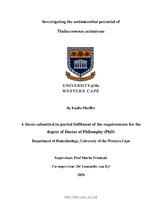| dc.description.abstract | The World Health Organisation predicts that by the year 2050, 10 million people could die annually as a result of infections caused by multidrug resistant bacteria. Individuals with compromised immune systems, caused by underlying disease such as HIV, MTB and COVID-19, are at a greater risk. Antibacterial resistance is a global concern that demands the discovery of novel drugs. Natural products, used since ancient times to treat diseases, are the most successful source of new drug candidates with bioactivities including antibiotic, antifungal, anticancer, antiviral, immunosuppressive, anti-inflammatory and biofilm inhibition. Marine bioprospecting has contributed significantly to the discovery of novel bioactive NPs with unique structures and biological activities, superior to that of compounds from terrestrial origin. Marine invertebrate symbionts are particularly promising sources of marine NPs as the competition between microorganisms associated with invertebrates for space and nutrients is the driving force behind the production of antibiotics, which also constitute pharmaceutically relevant natural products. | en_US |

